- It’s we what do
- Cairns To Darwin
- Triumph 900 GT Pro
- Solo Mission: Weekend Blast To Bundarra
- Husqvarna 701 Enduro LR
- Two Heads Are Better Than One
- Adventurous Encounter
- GS Safari Is Go!
- Suzuki V-Strom 1050
- Lyndon Poskitt
- A Touch Of Paradise
- For Some Reason (FSR)
- Carrying Extra Fuel
- Paper Chase
- Andy Strapz Thermalz
- The Bag Lady with Mike Ferris
- Mechanical Sympathy with Miles Davis
- Lockdown Lowdown with Andy Strapz
- Karen’s Lockdown Highs And Lows with Karen Ramsay
- Checkout
- Fit Out
If you’re a fan of the Tiger 800 you’re about to go crazy- ape bonkers. The 900 Tigers look set to be everything that was great about the 800s, but with a heap of upgrades, more power and less weight. The Tiger 900 GT Pro is a good example.
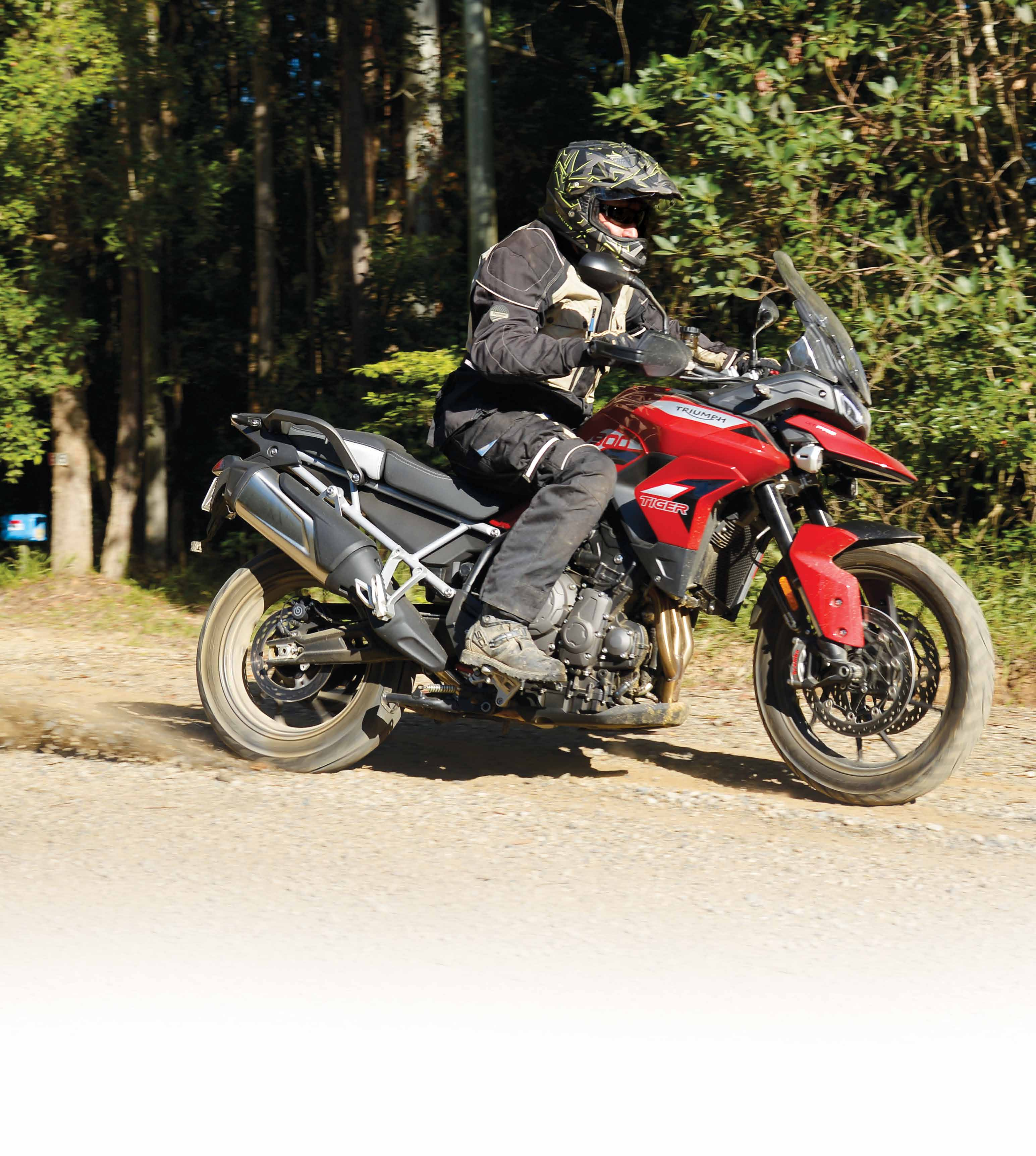
To make it easy to understand the new Tiger designations, the GT and GT Pro are similar to the Tiger 800XRs. They’re the more road-oriented option of the new Tiger 900s. The Rally and Rally Pro parallel the XC and XCA of previous years, and the ‘Pro’ designation is for the higher-spec bikes in the range.
We tried not to drool as a sparkling, gorgeous, Korosi red Tiger 900 GT Pro was wheeled from the Triumph showroom. It’s clearly a 50/50 bike with its cast, 17-inch and 19-inch wheels and Metzeler Tourances, and as we frantically reefed hard on the tie-downs and headed out of the city we could clearly see some long, dreamy days of backroad touring in front of us.
Pro heart
Triumph’s triples have always been among our favourite motors. Both the 800 and 1200 Tiger were fantastic bikes to ride on- and off-road, due in no small part to the incredible, linear power delivery of the smooth-running three-cylinder powerplants.
The 900s are an evolution of the 800 motors and have, of course, been through some development.
Capacity is now 888cc, and the firing order has changed to a 1-3-2 pattern which Triumph says is for ‘greater character’ and increased tractability at low revs. The single radiator of the 800 has been replaced with a twin-radiator arrangement and the motor sits lower in the frame to assist with sharper handling.
 The Tiger 900 GT Pro is a sharp performer aimed at predominantly road use. We still had a lot of fun with it on dirt roads.
The Tiger 900 GT Pro is a sharp performer aimed at predominantly road use. We still had a lot of fun with it on dirt roads.
Outright horsepower has increased, as has torque, up 10 per cent. The engine is Euro 5 compliant and drives through an assisted slipper clutch.
The new bike is lighter than its 800 counterpart – up to five kilos, depending on which models are being compared – fuel capacity has increased, and, in general,the bikes have up-specced from previous models with equipment like Brembo Stylema Monobloc braking.
And what modern tourer could hold its head up without a TFT screen and a stack of electronic rider aids?
The 900 GT Pro ridden here has a 17.8cm TFT screen that’s so sexy we nearly melted when we saw it. Because we had the Pro model, an ‘integrated connectivity system’ is included. That basically means the bike’s on-board systems connect with a smart phone and allow everything from music to navigation on the phone to be controlled from the ’bars and displayed on the TFT screen. Triumph built in a waterproof protective case under the seat, complete with power supply, and it’s clearly intended riders will park the phone there while they’re riding and avoid any unwanted attention from constabulary.
Of course, there are a stack of modes and LED lighting, and because this was the Pro, there were also heated grips, heated seats, shift assist, cornering ABS and traction control, tyre-pressure monitoring and electronic control of the shock preload.
The bike is a wet dream on wheels for the long-distance brigade who like a sporty edge.
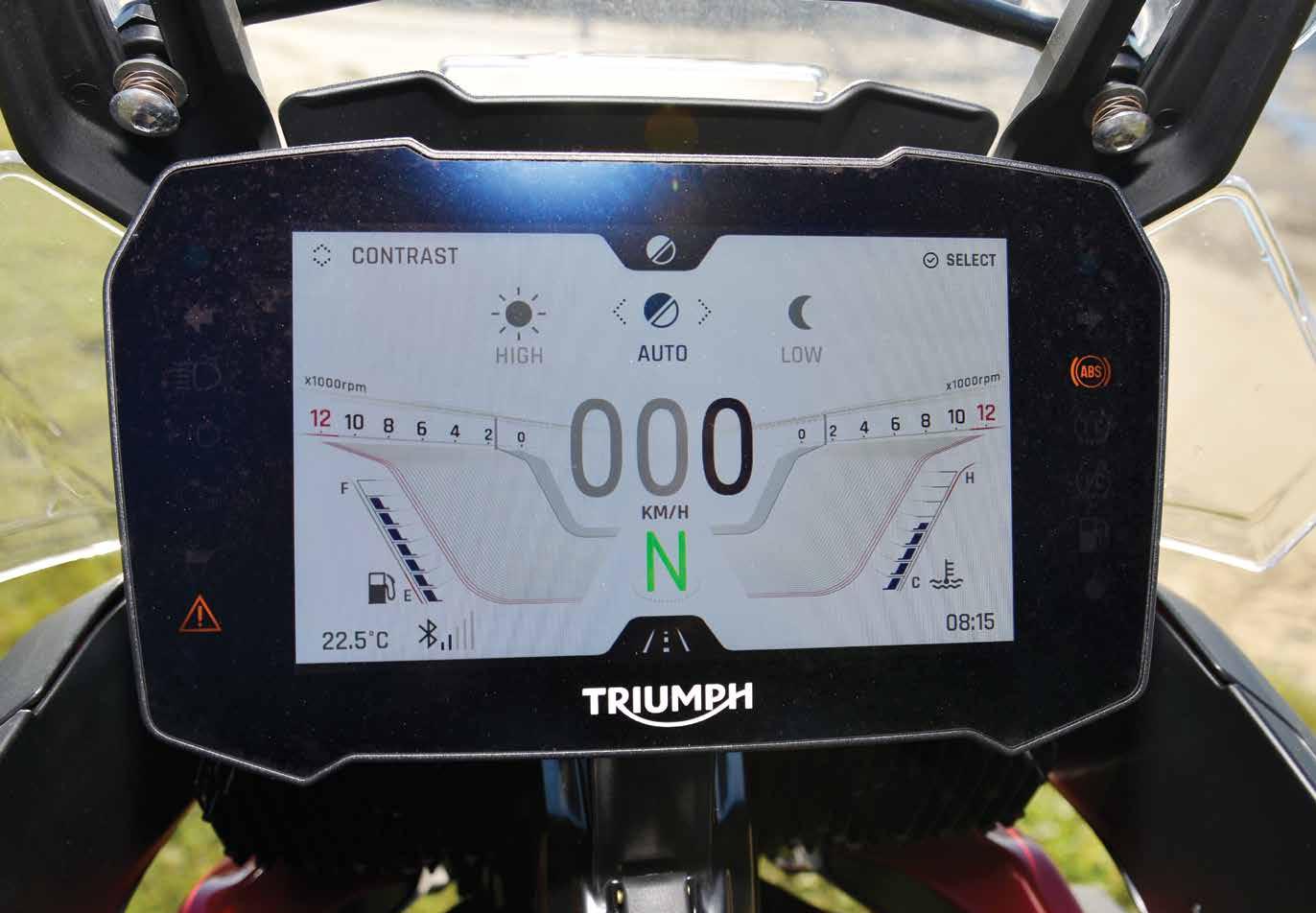 Still images can’t do justice to the TFT screen. It’s fairly spectacular. When the display is set on ‘auto’ it continually flicks between day and night – a white background and a black background – as the bike goes through shadows. We found it annoying and set it to ‘night’ and left it there.
Still images can’t do justice to the TFT screen. It’s fairly spectacular. When the display is set on ‘auto’ it continually flicks between day and night – a white background and a black background – as the bike goes through shadows. We found it annoying and set it to ‘night’ and left it there.
Screen time
Before we could climb on board the new Tiger we had to join the rest of the world and pair the phone to the bike. Our blank look must’ve sent a message as clear as a frequency-modulated radio signal, because Triumph’s incredibly patient representative slowly guided us through downloading the Triumph app and the pairing process – not without a few mumbled comments about how old the phone was. It seems a few years is the definition of ‘ancient’ in the high-tech communications world.
But with that process completed and the phone safely stowed we climbed on board, flicked the key around to light up the TFT screen and prepared for action.
Except there were a further multitude of possibilities offered on the screen, which itself has a few different modes or presentations.
Triumph’s menu system isn’t difficult, and thanks to having enjoyed several Triumphs over the years as the bikes and systems advanced, we were able to grasp it all fairly quickly.
The main feature everyone wants to understand straight away is how to select a riding mode. On the Tiger now it’s the same as it’s been since the last 1200 we rode: push the ‘m’ button on the left-hand switchblock, use the little joystick under the left thumb to move right or left to highlight the required mode, then push the little joystick in to select. Pull in the clutch at zero throttle and it’s done.
If everything turns to chocolate mousse, hit the home button on the right-hand switchblock and start all over again.
The switches are lit by internal LEDs, by the way, a very nice touch.Changes can be made on the fly and it’s an easy system to use. The odd-bod is changing into, or out of, any mode where ABS and/or traction control is off.
That requires the bike being stationary.
 The GT Pro is a bottler for sightseeing and covering distance, especially for those who like the occasional high-speed strop when circumstances allow.
The GT Pro is a bottler for sightseeing and covering distance, especially for those who like the occasional high-speed strop when circumstances allow.
Choose to suit
With the preliminaries sorted the fun began.
The GT is, in Triumph’s own words,‘transformed for even more urban adventure, proper long-distance travel and everything in between’.
We feel that was underselling the bike’s off-road capabilities a bit, but there’s no denying that, taken in the context of a lightweight tourer and occasional dirt-road squirter, the GT Pro is a pearler.
We didn’t feel a huge difference from the new firing order. The motor still seemed to give the linear power and torque delivery we loved on the 800, and the feel was very similar. It’s nice to use. Either getting playful on mountain roads or settling back with cruise control in charge on the highway, it’s an effortless pleasure. It can be lugged in a tall gear way down low in the rev range or it’ll keep delivering when it’s asked to scream its head off up near the redline.
That brings the modes into focus of course, and we messed around with the five on offer: Rain, Road, Sport, Off road and Rider. Rider mode allows the setting of each of the parameters, although, as far as we could see, those parameters could only be set to Triumph’s category titles, if you know what we mean. If we wanted to set a particular parameter,the choices would be on or off, or what-ever Triumph offered within the modes. There was no numerical setting available for it to be a bit one way or the other. ABS, for example, could be on, off, or Off road, which meant it was active on the front only.
That was more than enough choice for us, and after a great deal of trial we ended up using only Sport, Off road and, on odd occasions, Rider. Sport is a go-like-stink, smile-a-mile-wide option for carving up on the bitumen. Intervention from traction control and ABS was at its maximum and did a good job when things got scary. Off road was a little less frantic from the throttle, ABS was switched off at the rear, and traction control was sensible. We set up the Rider mode with no ABS and no traction control for those occasions when that was what called for. We don’t see the GT being asked to cope with a lot of deep sand or scary downhills, but it’s good to know the option is there.
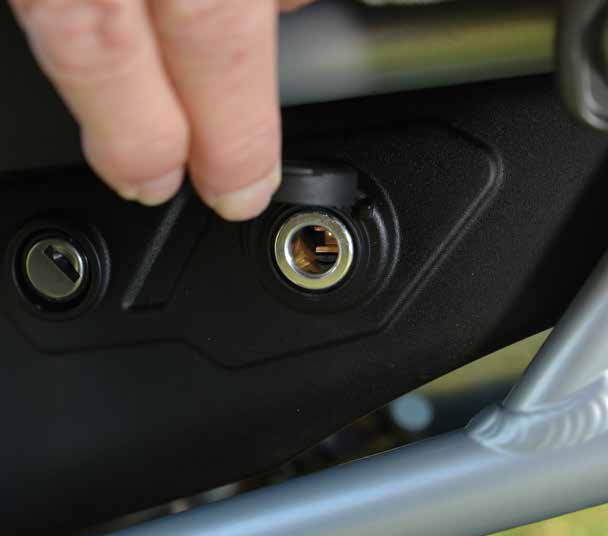 A 12-volt power supply just beneath the seat is a great feature. It’s the small Hella socket, not a cigarette-lighter size.
A 12-volt power supply just beneath the seat is a great feature. It’s the small Hella socket, not a cigarette-lighter size.
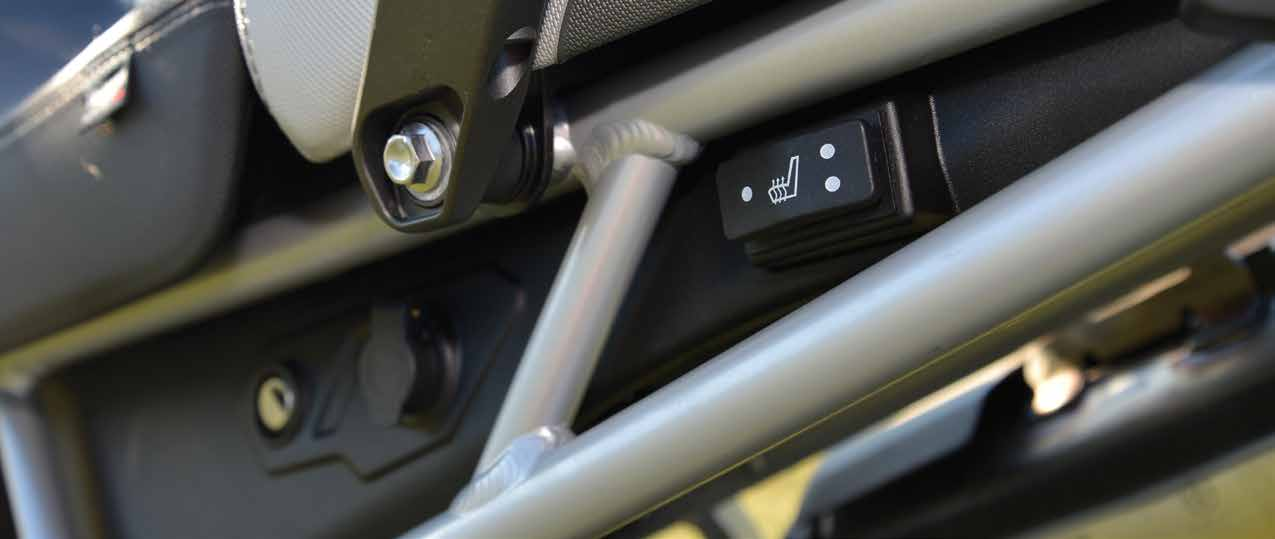 Heated seats! Crikey. The rider’s seat height has the rubber-band adjustment that’s been on the Tigers for ages. It’s simple and effective.
Heated seats! Crikey. The rider’s seat height has the rubber-band adjustment that’s been on the Tigers for ages. It’s simple and effective.
Level
Cornering ABS and traction control is a big feature on the bike, and we like the comfort of knowing it’s there on the asphalt. We’re rapt to say we didn’t have it save our backsides during our time with the bike, but anyone who can’t see the advantage of the systems is a mug. When we hit the dirt it was only a matter of pulling up and selecting Rider or Off road to ensure we could enjoy the fun, and that was a small price to pay to be able to cut loose and know the chance of a highside or lowside on the tar was greatly reduced, no matter how limited our talent.
The new Marzocchi suspension both ends is good and the electronic preload adjuster on the rear makes for an easy life.
Loading up with luggage and/or a pillion only requires a touch of the button to get the bike sitting level or close to it, and seeing as there’s no tools or crouching down needed, far more riders are likely to make the change. For that reason alone it’s a good idea.
The forks are fairly firm.
We liked them, but messed around a little because we felt they were a touch unforgiving on our test section. It’s a nasty section, and that’s why we go there, but it’s the type of terrain a rider on this type of bike could reasonably expect to encounter. For what it’s worth we went from seven clicks out on the compression to three clicks out and felt we were better off. Like all suspension tuning, it’s very individual, so don’t go making notes for the same adjustment if you ride the bike yourself. Do have a play with the clickers, though. There’s plenty of scope for adjustment.
Both front and rear work well, especially on the road.
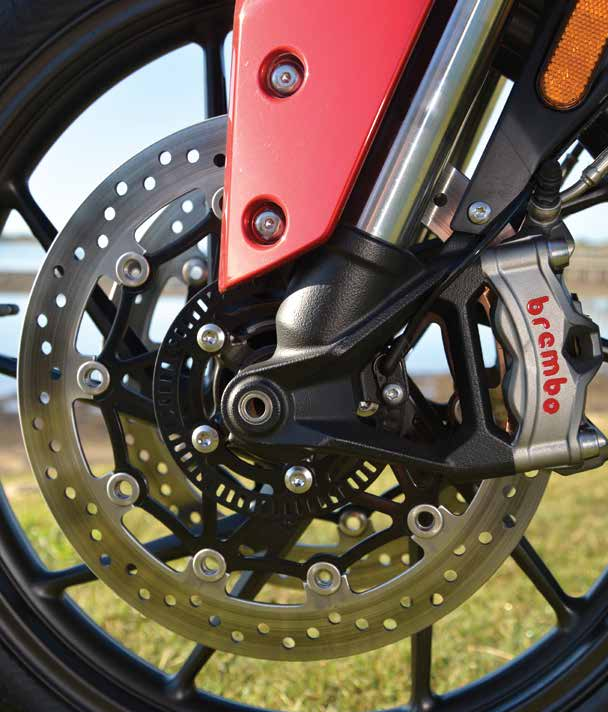 Braking is Brembo, and it’s first-class.
Braking is Brembo, and it’s first-class.
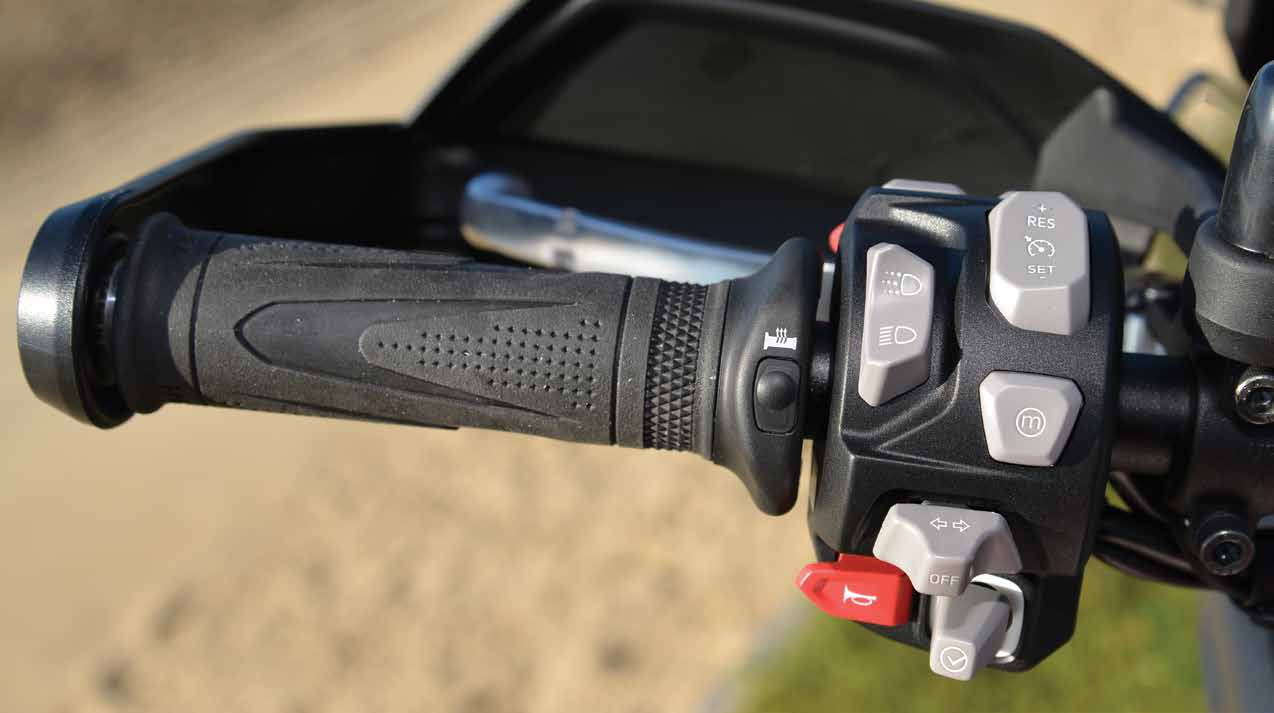 The switchblocks aren’t too crowded and the menu system was fairly easy to understand and use.
The switchblocks aren’t too crowded and the menu system was fairly easy to understand and use.
Finish
We’re holding back a bit here because while we loved the GT Pro, we have a lump in our tweeds for the Rally and Rally Pro, and this bike only confirmed how good we expect the more off-road versions to be.
For those who perhaps don’t chase the more-challenging terrain, especially those who want to sit back and watch huge chunks of Australia roll by on long, untroubled days, the GT Pro is a premium option. The finish and detail is absolutely gorgeous, as it has been on every Triumph we’ve seen in the last 10 or 15 years, and the bike is ready to sit up and join in with anything the rider wants to do, whether that’s explode through alpine bends working the Shift Assist – which worked well up and down through the six-speed box – or wander along a dirt road wondering where it goes. Fuel consumption during our time with the bike was around 19km per litre, so the 20-litre tank gives a range of around 380km. Let’s say 350km to leave a safety margin. That’s plenty in a bike like this one.
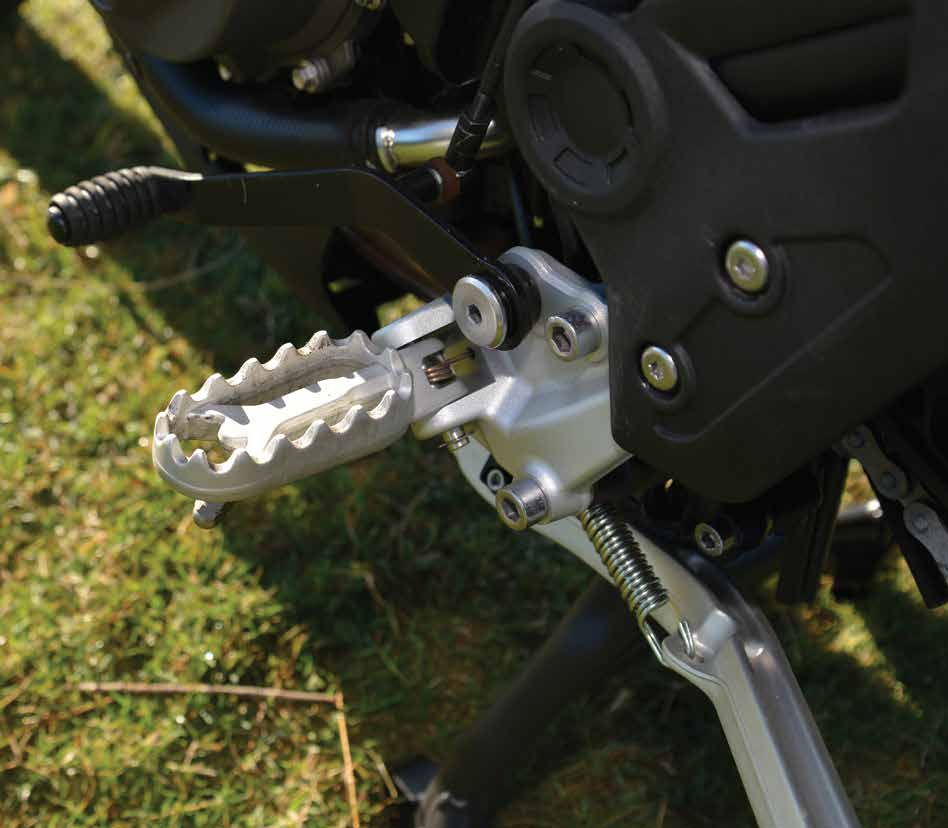 We removed the rubber inserts from the footpegs before we rode the bike. They pull out, no tools needed. The ’pegs are a good size.
We removed the rubber inserts from the footpegs before we rode the bike. They pull out, no tools needed. The ’pegs are a good size.
The phone connection was nice. We didn’t make the most of it because it stretched our tech comfort zone quite a bit, but seeing the name of a caller pop up on the TFT screen, choosing a song or two and even reading texts without having to do any-thing more than look down was awesome. GPS navigation is available too, but we forgot how to make it happen. There’s no doubt a whole wide tech world we’re missing out on, and we need to get cracking on catching up.
At the end of it all, the Tiger 900 GT Pro is a stunner and has everything we’ve always loved about the Triumph’s Tiger since we first rode one a decade ago. There’s a big range of Triumph luggage and accessories available, including two ‘packs’. The Trekker Pack has a Trekker 52-litre top box and mounting system, Trekker panniers and mounting system, top-box backrest, tank pad and adjustable screen deflector. The Expedition Pack has Silver Expedition panniers and mounting system, fork protectors, aluminium dual radiator guard, fuel tank crash bars, headlight guard and a waterproof 40-litre roll-top bag. So the bike can be set up and ready to go straight from the dealer floor. It’s a superb, versatile performer and a really beautiful and comfortable choice for long hours and long distance.
We can’t wait to get hold of a Rally.
Triumph 900 GT Pro
Recommended retail: $21,950 plus on-road costs.
Web: triumphmotorcycles.com.au

Engine type: Liquid-cooled, 12-valve, DOHC, in-line four-stroke
Capacity: 888cc
Bore x stroke: 78.0mm x 61.9mm
Compression ratio: 11.27:1
Maximum power: 93.9hp (70kW) @ 8750rpm
Maximum torque: 87Nm @ 7250rpm
System: Multipoint sequential electronic fuel injection
Exhaust: Stainless-steel three-into-one header system with side-mounted stainless-steel silencer
Final drive: O-ring chain
Clutch: Wet, multi-plate
Gearbox: Six-speed
Frame: Tubular-steel frame, bolt-on subframe
Front wheel: Cast alloy, 19-inch x 2.5-inch
Rear wheel: Cast alloy, 17-inch x 4.25-inch
Front tyre: 100/90-19
Rear tyre: 150/70R-17
Front suspension: Marzocchi 45mm upside-down forks, manual rebound and compression damping adjustment 180mm (140mm GT LRH)
Rear suspension: Marzocchi rear-suspension unit, electronically adjustable preload and rebound damping, 170mm travel
Front brake: Twin 320mm floating discs, Brembo Stylema four-piston Monobloc calipers. Radial front master cylinder, Optimised Cornering ABS
Rear brake: Single 255mm disc. Brembo single-piston sliding caliper. Optimised Cornering ABS
Handlebar width: 930mm
Height without mirrors: 1410mm – 1460mm
Seat height: 810mm – 830mm
Wheelbase: 1556mm
Dry weight: 198kg
Fuel capacity: 20 litres
Colours: Korosi red, Sapphire black, Pure white
Service intervals: First service at 1000km, then every 16,000km or 12 months, whichever comes first



















Comments